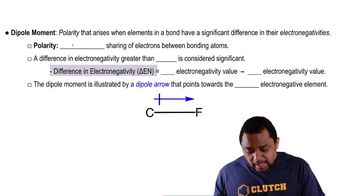Textbook Question
Determine whether each molecule in Exercise 35 is polar or nonpolar.
a. CI4
b. NCl3
c. OF2
d. H2S

 Tro 6th Edition
Tro 6th Edition Ch.11 - Chemical Bonding II: Molecular Shapes, VSEPR & MO Theory
Ch.11 - Chemical Bonding II: Molecular Shapes, VSEPR & MO Theory Problem 51c
Problem 51c Verified step by step guidance
Verified step by step guidance



Determine whether each molecule in Exercise 35 is polar or nonpolar.
a. CI4
b. NCl3
c. OF2
d. H2S
Determine whether each molecule in Exercise 36 is polar or nonpolar.
a. CS2
b. SCl2
c. CHF3
d. PF3
Determine whether each molecule is polar or nonpolar. b. SiCl4
Determine whether each molecule is polar or nonpolar.
a. IF5
b. SCl2
c. SCl4
d. BrF5
The valence electron configurations of several atoms are shown here. How many bonds can each atom make without hybridization? a. N 2s22p3
The valence electron configurations of several atoms are shown here. How many bonds can each atom make without hybridization? b. B 2s2sp1